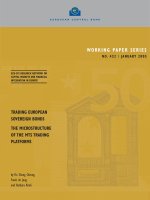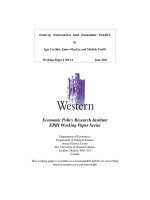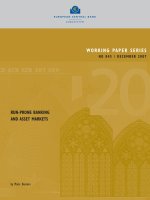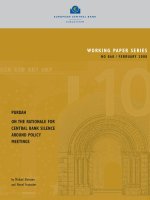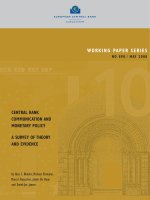WORKING PAPER SERIES 141 - FORECASTING BONDS YIELDS IN THE BRAZILIAN FIXED INCOME MARKET ppt
Bạn đang xem bản rút gọn của tài liệu. Xem và tải ngay bản đầy đủ của tài liệu tại đây (350.05 KB, 30 trang )
141
141
ISSN 1518-3548
Forecasting Bonds Yields in the Brazilian Fixed Income Market
Jose Vicente and Benjamin M. Tabak
August, 2007
Working Paper Series
ISSN 1518-3548
CGC 00.038.166/0001-05
Working Paper Series
Brasília
n. 141
Aug
2007
P. 1-29
Working Paper Series
Edited by Research Department (Depep) – E-mail:
Editor: Benjamin Miranda Tabak – E-mail:
Editorial Assistent: Jane Sofia Moita – E-mail:
Head of Research Department: Carlos Hamilton Vasconcelos Araújo – E-mail:
The Banco Central do Brasil Working Papers are all evaluated in double blind referee process.
Reproduction is permitted only if source is stated as follows: Working Paper n. 141.
Authorized by Mário Mesquita, Deputy Governor for Economic Policy.
General Control of Publications
Banco Central do Brasil
Secre/Surel/Dimep
SBS – Quadra 3 – Bloco B – Edifício-Sede – 1º andar
Caixa Postal 8.670
70074-900 Brasília – DF – Brazil
Phones: (5561) 3414-3710 and 3414-3567
Fax: (5561) 3414-3626
E-mail:
The views expressed in this work are those of the authors and do not necessarily reflect those of the Banco Central or
its members.
Although these Working Papers often represent preliminary work, citation of source is required when used or reproduced.
As opiniões expressas neste trabalho são exclusivamente do(s) autor(es) e não refletem, necessariamente, a visão do Banco
Central do Brasil.
Ainda que este artigo represente trabalho preliminar, citação da fonte é requerida mesmo quando reproduzido parcialmente.
Consumer Complaints and Public Enquiries Center
Address: Secre/Surel/Diate
Edifício-Sede – 2º subsolo
SBS – Quadra 3 – Zona Central
70074-900 Brasília – DF – Brazil
Fax: (5561) 3414-2553
Internet:
Forecasting Bond Yields in the Brazilian Fixed
Income Market
∗
Jose Vicente
†
Benjamin M. Tabak
‡
The Working Papers should not be reported as representing the views
of the Banco Central do Brasil. The views expressed in the papers are
those of the author(s) and not necessarily reflect those of the Banco
Central do Brasil.
Abstract
This paper studies the predictive ability of a variety of models in
forecasting the yield curve for the Brazilian fixed income market. We
compare affine term structure models with a variation of the Nelson-
Siegel exponential framework developed by Diebold and Li (2006).
Empirical results suggest that forecasts made with the latter method-
ology are superior and appear accurate at long horizons when com-
pared to different benchmark forecasts. These results are important
for policy makers, portfolio and risk managers. Further research could
study the predictive ability of such models in other emerging markets.
Keywords:term structure of interest rates; term premia; monetary
policy; affine term structure models
JEL Code:E43; G12.
∗
The views expressed are those of the authors and do not necessarily reflect the views of
the Central Bank of Brazil. Benjamin M. Tabak gratefully acknowledges financial support
from CNPQ Foundation.
†
Banco Central do Brasil. E-mail:
‡
Banco Central do Brasil. E-mail:
3
1 Introduction
Accurate interest rates forecasts are essential for policy-makers, bankers,
treasurers and fixed income portfolio managers. These forecasts are main
ingredients in the development of macroeconomic scenarios, which are em-
ployed by large companies, financial institutions, regulators, institutional
investors, among others. Nonetheless, to date there is very little research on
interest rates forecasting and specially on yield curve forecasting.
Duffee (2002), Dai and Singleton (2002) and Ang and Piazzesi (2003)
employ Gaussian affine term structure models and are successful in match-
ing certain properties of the U.S. term structure movement and generating
time-varying term premia. Recent literature has studied the joint dynamics
of the term structure and the macroeconomy in a general equilibrium frame-
work. Wu (2006) for example develops an affine term structure model within
a dynamic stochastic general equilibrium framework and provides macroeco-
nomic interpretations of the term structure factors. The author argues that
changes in the “slope” and “level” factors are driven by monetary policy and
technology shocks, respectively. However, these models focus on fitting term
structure models but provide poor forecasts of the yield curve.
Other researchers have studied the forecasting accuracy of interest rates
surveys and show that such forecasts correctly predicted the direction of
changes in long-term interest rates for the US (see Greer (2003)). Bidakorta
(1998) compares the forecasting performance of univariate and multivariate
models for real interest rates for the US and finds that bivariate models
perform quite well for short-term forecasting.
In a recent paper Diebold and Li (2006) propose a model, which is based
on the Nelson-Siegel exponential framework for the yield curve, to forecast
the yield curve. The authors present convincing evidence that their model is
superior to more traditional ones such as vector autoregression, random walk
and forward rate and curve regressions. They show that the model provides
more accurate forecasts at long horizons for the US term structure of interest
rates than standard benchmark forecasts.
Despite the advances in forecasting yields for the US economy there is
very little research applied to emerging markets. However, some emerging
countries have large debt and equity markets and receive substantial inflows
of foreign capitals, playing an important role in the international capital mar-
kets. Brazil deserves attention as it has large equity and debt markets, with
liquid derivatives markets, and therefore represents interesting opportunities
4
for both domestic and international investors. Brazil has the largest stock
of bonds in absolute terms and as a percentage of GDP in Latin American
bond markets. In the Brazilian fixed-income market domestic federal public
debt is the main asset, with approximately R$ 1 trillion (US$ 545 billions)
in June 2006.
In a recent paper Luduvice et al. (2006) study different models for the
forecasting of interest rates in Brazil. They compare the forecasting accuracy
of vector autoregressive (VAR) and vector error correction (VEC) models
with naive forecasts from a simple random walk model. The authors find
that VAR/VEC models are not able to produce forecasts that are superior
to the random walk benchmark
1
. This paper is the first that attempts to
study interest rates forecast for the Brazilian economy, however it focuses on
long-term interest rates forecasts.
Our paper contributes to the literature by estimating and calibrating a va-
riety of models to the Brazilian term structure of interest rates and comparing
their forecast accuracy. The accuracy of out-of-sample forecasts is evaluated
using usual mean squared errors and Diebold-Mariano statistics. Empirical
results suggest that the Diebold-Li (2006) model has good forecasting power
if compared with an affine term structure model and the random walk bench-
mark, especially for short-term interest rates. Therefore, it provides a good
starting point for research applied to emerging markets.
The remainder of the paper is organized as follows. Section 2 presents
the data and stylized facts, while section 3 discusses the the Diebold and Li
(2006) methodology and an affine term structure model. Section 4 presents
a comparison of forecasts made by each model while section 5 concludes.
2 Data and stylized facts
The main data employed in this study are interest rates swaps maturing in 1,
2, 3, 6, and 12 months’ time. In these swaps contracts, a party pays a fixed
rate over an agreed principal and receives floating rate over the same prin-
cipal, the reverse occurring with his counterpart. There are no intermediate
cash-flows and contracts are settled on maturity. Therefore, we use as proxies
for yields the fixed rates on swap contracts, negotiated in the Brazilian fixed
1
They, however, find that VAR/VEC models are able to capture future changes in the
direction of changes in interest rates.
5
income market
2
.
The data is sampled daily and we build monthly observations by averaging
daily yields. The sample begins in May 1996 and ends in November 2006,
with 127 monthly observations.
Table 1 presents descriptive statistics for yields. The typical yield curve is
upward sloping for time period under analysis. The slope and curvature are
less persistent than individual yields. Both the slope and curvature present
low standard deviations if compared to individual yields.
Place Table 1 About Here
Figure 1 presents the dynamics of yields for the period under study.
Place Figure 1 About Here
It is important to note that the level and slope are not significantly cor-
related with each other (it is never larger than 30%). Curvature is also not
significantly correlated with the level, however, it’s highly correlated with the
slope (approximately -70%). This suggests that perhaps two factors (level
and slope) may explain well the term structure. This is particularly true for
the Brazilian term structure of interest rates as for liquidity reasons we have
yields only up to 12-months maturity (which may be seen as the short-term
part of the term structure.
3 Yield Curve Models
3.1 Diebold-Li Model
Litterman and Scheinkman (1991) study the US yield curve, which has a
pronounced hump-shape, and conclude that three factors (level, slope and
curvature) are required to explain movements of the whole term structure of
interest rates. However, most studies have concluded that the level factor is
the most important in explaining interest rate variation over time.
Most yield curve models include the three factors to account for interest
rates dynamics. Diebold and Li (2006) suggest the following three-factor
model:
2
Unfortunately we do not have information on Brazilian bond yields for long time
periods. Therefore, we are not able to employ Brazilian bond yields directly.
6
y
t
(τ) = β
1t
+ β
2t
(
1 − e
−λ
t
τ
λ
t
τ
) + β
3t
(
1 − e
−λ
t
τ
λ
t
τ
− e
−λ
t
τ
), (1)
The authors interpret the coefficients β
1t
, β
2t
and β
3t
as three latent
dynamic factors. They can be seen as factors for the level, slope and curva-
ture. The λ
t
determines the maturity at which the loading on the curvature
achieves it smaximum.
In order to estimate the parameters β
1t
, β
2t
, β
3t
, λ for each month t non-
linear least squares could be used. However, the λ
t
value can be fixed and
set equal to the value that maximizes the loading on the curvature factor.In
this case, one can compute the values of the factor loadings and use ordinary
least squares to estimate the factors (betas), for each month t. We follow this
approach and also let λ vary freely and compare the forecasting accuracy of
both procedures.
The next step in the Diebold and Li (2006) approach is to assume that the
latent factors follow an autoregressive process, which is employed to forecast
the yield curve.
The forecasting specification is given by:
ˆy
t+h/t
(τ) =
ˆ
β
1t,t+h/t
+
ˆ
β
2t,t+h/t
(
1 − e
−λ
t
τ
λ
t
τ
) +
ˆ
β
3t,t+h/t
(
1 − e
−λ
t
τ
λ
t
τ
− e
−λ
t
τ
), (2)
where
ˆ
β
i,t+h/t
= c
i
+ ˆγ
i
ˆ
β
it
, i = 1, 2, 3, (3)
and ˆc
i
and ˆγ
i
are coefficients obtained by estimating a first-order autore-
gressive process AR(1) on the coefficients
ˆ
β
it
.
Table 2 presents the results for the estimation of the three factors in the
Diebold-Li representation of the Nelson-Siegel model. All three factors are
highly persistent and exhibit unit roots, with the exception of β
1t
in which
we reject the null hypothesis at the 10% significance level. These results are
similar to the ones obtained in Diebold and Li (2006) and suggest that the
factor for the level is more persistent than the factors for slope and curvature.
Place Table 2 About Here
7
3.2 Affine Term Structure Models
In recent years the class of affine term structure models (ATSMs) has become
the main tool to explain stylized facts concerning term structure dynamics
and pricing fixed income derivatives. Basically ATSMs are multifactor dy-
namic term structure models such that the state process X is an affine diffu-
sion
3
and the short term rate is affine in X. From Duffie and Kan (1996) we
know that ATSMs yield closed-form expressions for zero coupon bond prices
(up to solve a couple of Riccati differential equations) and zero coupon bond
yields are also affine functions of X
4
.
In order to study problems related to admissibility
5
and identification of
these models, Dai and Singleton (2000) proposed a useful classification of
ATSMs according to the number of state variables driving the conditional
variance matrix of X. For example, when there are three sources of un-
certainty
6
, they group all three-factor ATSMs in four non-nested families:
A
m
(3), m = 0, 1, 2 and 3, where m is the number of factors that determine
the volatility of X. When m = 0 the volatility of X is independent of X
and the state process follows a three-dimensional Gaussian diffusion. On the
order hand (m = 3) all three state variables drive conditional volatilities.
In this work we adopt a version of the A
0
(3) proposed by Almeida and
Vicente (2006)
7
. The short term rate is characterized as the sum of three
stochastic factors:
r
t
= φ
0
+ X
1
t
+ X
2
t
+ X
3
t
,
where the dynamics of process X under the martingale measure Q is given
by
dX
t
= −κX
t
dt + ρdW
Q
t
,
with W
Q
being a three-dimensional independent brownian motion under Q,
κ a diagonal matrix with κ
i
in the i
th
diagonal position, and ρ is a matrix
responsible for correlation among the X factors.
3
This means that the drift and the diffusion terms of X are affine functions of X.
4
See also Filipovic (2001).
5
An affine model is admissible when the bond prices are well-defined.
6
There is a consensus in the literature of fixed income that three factors are sufficient
to capture term structure dynamics. See Litterman and Scheinkman (1991) for a seminal
factor analysis on term structure data.
7
We remind the reader that our principal aim is to forecast bond yields. Then A
0
(3) is
a natural choice since in this ATSM family all factors capture information about interest
rate (there is no stochastic factor collecting information about the volatility process).
Duffee (2002) tests the forecast power of ATSMs and shows that this intuition is true.
8
Following Duffee (2002) we specify the connection between martingale
probability measure Q and physical probability measure P through an essen-
tially affine market price of risk
dW
P
t
= dW
Q
t
−
λ
0
+ λ
1
X
t
dt,
where λ
0
is a three-dimensional vector, λ
1
is a 3 × 3 matrix and W
P
is a
three-dimensional independent brownian motion under P.
On this special framework the Riccati equations, which defined bonds
prices, have a simple solution. Almeida and Vicente (2006) show that the
price at time t of a zero coupon bond maturing at time T is
P (t, T ) = e
A(t,T )+B(t,T )
′
X
t
,
where B(t, T ) is a three-dimensional vector with −
1 − e
−κ
i
τ
κ
i
in the i
th
element
and
A(t, T ) = −φ
0
τ +
1
2
3
i=1
1
κ
2
i
τ +
2
κ
i
e
−κ
i
τ
−
1
2κ
i
e
−2κ
i
τ
−
3
2κ
i
3
j=1
ρ
2
ij
+
3
i=1
k>i
1
κ
i
κ
k
τ +
e
−κ
i
τ
− 1
κ
i
+
e
−κ
k
τ
− 1
κ
k
−
e
−(κ
i
+κ
k
)τ
− 1
κ
i
+ κ
k
3
j=1
ρ
ij
ρ
kj
,
with τ = T − t.
The model parameters are estimated using the maximum likelihood proce-
dure described in Chen and Scott (1993)
8
. We assume that the zero-coupon-
bonds with maturity 1 month, 6 months and 1 year are pricing without
error. For the zero-coupon-bonds with maturity 2 months and 3 months,
we assume observations with gaussian errors uncorrelated along time. To
find the vector of parameters which maximizes the likelihood function we
use the Nelder-Mead Simplex algorithm for non-linear functions optimiza-
tion (implemented in the MatLab
TM
fminsearch function)
9
. Table 3 presents
the values of the parameters as well as asymptotic standard deviations to
8
For a brief description of this technique see Almeida and Vicente (2006).
9
The parameters are constrained for admissibility purposes (see Dai and Singleton
(2000).
9
test their significance (parameters not shown on the table are fixed equal to
zero).
Place Table 3 About Here
4 Comparison of Forecasting Models
In this section we examine the forecast performance of the Diebold-Li (2006)
model assuming a constant λ and allowing for a variable λ with an affine
term structure model and the random walk benchmark.
Our forecast accuracy comparisons are based on series of recursive fore-
casts, which are computed in the following way. We use the first half of
the sample to estimate the models and build forecasts from one-month to
twelve-months ahead. We then include a new observation in the sample and
the parameters are re-estimated and new forecasts are constructed. This pro-
cedure is repeated until the end of the sample. These out-of-sample forecasts
are used to compute the various measures of forecasts accuracy for yields of
different maturities.
The forecasts of the affine term structure model follow Duffee (2002) and
therefore we employ half of the sample to estimate the model and then build
the forecasts. However, we do not re-estimate the parameters.
Table 4 records the results for the mean squared error (MSE) of each
of the models used to forecast the term structure of interest rates. It is
possible to see that for one-month ahead forecasts the MSE of the random
walk benchmark is lower than most of the competitor models. However,
as we increase the forecasting horizon the Diebold and Li (DL and DL with
variable λ) models seem to gain forecasting accuracy and present lower MSE.
Place Table 4 About Here
Table 5 presents Diebold-Mariano (1995) tests for equal forecast accu-
racy. Under the null hypothesis of equal forecast accuracy this statistic has
a standard normal asymptotic distribution. We compare all the models with
the random walk benchmark. Empirical results suggest that the DL model
provides better forecasting accuracy than the random walk benchmark for
interest rates up to three-months for twelve-months ahead forecasts (long-
term). However, evidence suggests that the random walk provides better
short-term forecasts.
Place Table 5 About Here
10
5 Final Considerations
This paper compares the yield curve forecasting accuracy of the Diebold
and Li (2006), affine term structure and random walk models. The empir-
ical results suggest that the Diebold and Li (2006) model provides superior
forecasts, specially at longer time horizons for short-term interest rates.
This is the first paper that presents some evidence of forecasting accu-
racy for the Brazilian yield curve, with promising results. These results are
important for fixed-income portfolio managers, institutional investors, finan-
cial institutions, financial regulators, among others. They are particularly
useful for countries that have implemented explicit inflation targets and use
short-term interest rates as policy instruments such as Brazil.
The models proposed in this paper may be used for policy purposes as
they may prove useful in the construction of long-term scenarios for the yield
curve. Nonetheless, more research is needed to develop models that may
provide reasonable short-term forecasts.
Further research could expand the set of models employed to compare
forecasting accuracy and study other emerging markets. Perhaps models
that incorporate other macroeconomic variables would perform well as well.
Finally, it would be quite interesting to compare Asian and Latin American
bond markets.
11
References
[1] Ang, A. and M. Piazzesi (2003). A No-Arbitrage Vetor Autoregression
of Term Structure Dynamics with Macreconomics and Latent Variables.
Journal of Monetary Economics, 50, 745-787.
[2] Bidarkota, P.V. (1998). The comparative forecast performance of uni-
variate and multivariate models: an application to real interest rate
forecasting. International Journal of Forecasting, 14, 457-468.
[3] Chen R.R. and L. Scott (1993). Maximum Likelihood Estimation for a
Multifactor Equilibrium Model of the Term Structure of Interest Rates.
Journal of Fixed Income, 3, 14-31.
[4] Dai Q. and K. Singleton (2000). Specification Analysis of Affine Term
Structure Models. Journal of Finance, LV, 5, 1943-1977.
[5] Dai Q. and K. Singleton (2002). Expectation Puzzles, Time-Varying
Risk Premia, and Affine Models of the Term Structure. Journal of Fi-
nancial Economics, 63, 415-441.
[6] Diebold F. and C. Li (2006). Forecasting the Term Structure of Govern-
ment Yields. Journal of Econometrics, 130, 337-364.
[7] Duffee G. R. (2002). Term Premia and Interest Rates Forecasts in Affine
Models. Journal of Finance, 57, 405-443.
[8] Duffie D. and R. Kan (1996). A Yield Factor Model of Interest Rates.
Mathematical Finance, Vol. 6, 4, 379-406.
[9] Filipovic, D. (2001). A General Characterization of one Factor Affine
Term Structure Models. Finance and Stochastics, 5, 389-412.
[10] Greer, M. (2003). Directional accuracy tests of long-term interest rate
forecasts. International Journal of Forecasting, 19, 291-298.
[11] Litterman R. and J.A. Scheinkman (1991). Common Factors Affecting
Bond Returns. Journal of Fixed Income, 1, 54-61.
[12] Lima, E. A., Luduvice, F., and Tabak, B.M. (2006). Forecasting Interest
Rates: an application for Brazil. Working Paper Series of Banco Central
do Brasil, 120.
12
[13] Nelson C.R. and A.F. Siegel (1987). Parsimonious Modeling of Yield
Curves. Journal of Business, 60, 4, 473-489.
[14] C. Almeida and Vicente J.V.M. (2006). Term Structure Movements Im-
plicit in Option Prices. Working Paper, Graduate School of Economics,
Getulio Vargas Foundation.
[15] Wu,T.(2006). Macro Factors and the Affine Term Structure of Interest
Rates. Journal of Money, Credit, and Banking, 38, 7, 1847-1875.
13
Maturity (Months) Mean Std. Dev. Maximum Minimum ρ(1) ρ(12) ρ(24)
1 0.192 0.050 0.379 0.127 0.878 0.268 -0.017
2 0.192 0.049 0.389 0.126 0.880 0.255 -0.020
3 0.193 0.048 0.390 0.125 0.878 0.249 -0.023
6 0.196 0.047 0.378 0.123 0.882 0.242 -0.041
12 0.200 0.049 0.383 0.122 0.893 0.249 -0.072
Slope 0.008 0.024 0.070 -0.056 0.815 0.096 0.140
Curvature -0.006 0.013 0.023 -0.044 0.774 0.141 0.137
Table 1: This Table presents descriptive statistics for monthly yields at different maturities. The slope is
defined as the difference between the 1-year and 1-month yields and the curvature is defined as twice the
3-months yield minus the sum of the 1-month and 1-year yields. We present sample autocorrelations for 1,
12 and 24 months.
14
Factor Mean Std. Dev Maximum Minimum ρ(1) ρ(12) ADF
ˆ
β
1t
20.93 5.71 37.28 14.28 0.92 0.16 -3.26*
ˆ
β
2t
-2.19 5.15 6.06 -14.91 0.89 -0.02 -2.76
ˆ
β
3t
-2.22 5.13 5.14 -15.71 0.80 -0.11 -1.19
Table 2: This Table presents descriptive statistics for the three factors in
the model proposed in Diebold and Li (2006) using monthly data 1996:05-
2001:03. The last column presents Augmented Dickey-Fuller unit root tests
(ADF). The symbol * refers to the rejection of the null hypothesis of the
existence of a unit root at the 10% significance level.
15
Parameter Value Standard Error t-statistics
κ
1
4.4172 0.2333 18.92
κ
2
1.9644 0.0472 41.61
κ
3
-0.0091 0.004736 -1.93
ρ
11
0.2343 0.0149 15.64
ρ
21
-0.1935 0.0256 -7.54
ρ
22
0.1029 0.0433 2.38
ρ
31
0.0061 0.0006 9.86
ρ
32
-0.0396 0.0381 -1.04
ρ
33
0.0962 0.0056 17.23
λ
0
(1) 0.3165 0.5062 0.63
λ
0
(2) -0.0885 0.1233 -0.72
λ
0
(3) 0.0505 0.0206 2.45
λ
1
(11) -0.9655 0.1536 -1.86
λ
1
(21) 0.0280 0.1015 2.15
λ
1
(22) 0.2440 0.0372 6.29
λ
1
(31) 0.1339 0.0418 1.73
λ
1
(32) 0.1339 0.3813 5.83
λ
1
(33) -0.4428 0.4865 -0.3511
φ
0
-0.4190 0.1272 -3.29
Table 3: Parameters and Standard Errors for the A
0
(3) Model. Significant
t-statistics are in bold.
16
Random Walk DL Affine DL - Variable λ
1-month forecast
y
1
0.001849236 0.002098129 0.001942738 0.002007605
y
2
0.002147072 0.002124832 0.002190248 0.002119687
y
3
0.002343081 0.002261082 0.002292119 0.002234052
y
6
0.002848165 0.00279635 0.002667497 0.00265806
y
12
0.003944768 0.004157651 0.003871837 0.003937806
3-months forecast
y
1
0.00968121 0.008476022 0.005507391 0.008411354
y
2
0.009745494 0.008301889 0.006192385 0.00826154
y
3
0.00982919 0.008714388 0.007090455 0.008495199
y
6
0.011502015 0.011626086 0.010849607 0.010857756
y
12
0.015798506 0.016691762 0.016312642 0.015771641
6-months forecast
y
1
0.028085384 0.019884699 0.016922863 0.019343557
y
2
0.028075811 0.020312088 0.019503393 0.019595936
y
3
0.028423832 0.021756182 0.022343976 0.020580832
y
6
0.031400518 0.028019025 0.030327459 0.025709813
y
12
0.038675424 0.037614651 0.039646336 0.035458477
12-months forecast
y
1
0.059509453 0.044203579 0.064503337 0.042265436
y
2
0.059953062 0.045234434 0.065901286 0.043484339
y
3
0.060051943 0.047615567 0.066767276 0.04532249
y
6
0.060061913 0.056668262 0.068369388 0.052883419
y
12
0.065191422 0.069434807 0.071529166 0.066702033
Table 4: This Table presents Mean Squared Errors for 1,3,6 and 12-months out-of sample forecasts for
different maturities. We compare the performance of the random walk, Diebold-Li (DL), Affine model and
Diebold-Li with variable λ.
17
1-month 3-months 6-months 12-months
DM p-value DM p-value DM p-value DM p-value
y
1
DL -2.33 0.99 -0.13 0.55 0.50 0.31 3.26 0.00
y
2
DL -1.84 0.97 0.34 0.37 0.64 0.26 5.27 0.00
y
3
DL -1.38 0.92 0.47 0.32 0.77 0.22 2.25 0.01
y
6
DL -0.84 0.80 0.042 0.48 0.43 0.33 -0.11 0.54
y
12
DL -1.88 0.97 -0.69 0.75 -0.51 0.70 -0.63 0.74
y
1
Affine -0.26 0.60 0.81 0.21 0.72 0.24 0.07 0.47
y
2
Affine -0.47 0.68 0.78 0.22 0.54 0.29 -0.06 0.53
y
3
Affine -0.32 0.63 0.72 0.23 0.42 0.34 0.01 0.50
y
6
Affine 0.57 0.28 0.21 0.42 0.09 0.46 0.16 0.44
y
12
Affine 0.17 0.43 -0.12 0.54 0.00 0.50 0.18 0.43
y
1
DL-Variable λ -2.52 0.99 -0.13 0.55 0.60 0.27 7.14 0.00
y
2
DL-Variable λ -2.01 0.98 0.33 0.37 0.77 0.22 0.00 0.50
y
3
DL-Variable λ -1.43 0.92 0.51 0.30 0.99 0.16 0.00 0.50
y
6
DL-Variable λ -0.25 0.59 0.36 0.36 0.91 0.18 0.24 0.41
y
12
DL-Variable λ -1.33 0.91 -0.41 0.66 -0.25 0.60 -0.58 0.72
Table 5: This Table presents Diebold Mariano (DM) with it’s respective p-values for 1,3,6 and 12-months
out-of sample forecasts for different maturities. We compare the performance of the random walk, Diebold-Li
(DL), Affine model and Diebold-Li with variable λ.
18
0%
5%
10%
15%
20%
25%
30%
May-96 Nov-96 May-97 Nov-97 May-98 Nov-98 May-99 Nov-99 May-00 Nov-00
Figure 1: 1, 2, 3, 6 and 12-months yields for the Brazilian economy1996:05-
2006:11.
19
20
Banco Central do Brasil
Trabalhos para Discussão
Os Trabalhos para Discussão podem ser acessados na internet, no formato PDF,
no endereço:
Working Paper Series
Working Papers in PDF format can be downloaded from:
1 Implementing Inflation Targeting in Brazil
Joel Bogdanski, Alexandre Antonio Tombini and Sérgio Ribeiro da Costa
Werlang
Jul/2000
2 Política Monetária e Supervisão do Sistema Financeiro Nacional no
Banco Central do Brasil
Eduardo Lundberg
Monetary Policy and Banking Supervision Functions on the Central
Bank
Eduardo Lundberg
Jul/2000
Jul/2000
3 Private Sector Participation: a Theoretical Justification of the Brazilian
Position
Sérgio Ribeiro da Costa Werlang
Jul/2000
4 An Information Theory Approach to the Aggregation of Log-Linear
Models
Pedro H. Albuquerque
Jul/2000
5 The Pass-Through from Depreciation to Inflation: a Panel Study
Ilan Goldfajn and Sérgio Ribeiro da Costa Werlang
Jul/2000
6 Optimal Interest Rate Rules in Inflation Targeting Frameworks
José Alvaro Rodrigues Neto, Fabio Araújo and Marta Baltar J. Moreira
Jul/2000
7 Leading Indicators of Inflation for Brazil
Marcelle Chauvet
Sep/2000
8 The Correlation Matrix of the Brazilian Central Bank’s Standard Model
for Interest Rate Market Risk
José Alvaro Rodrigues Neto
Sep/2000
9 Estimating Exchange Market Pressure and Intervention Activity
Emanuel-Werner Kohlscheen
Nov/2000
10 Análise do Financiamento Externo a uma Pequena Economia
Aplicação da Teoria do Prêmio Monetário ao Caso Brasileiro: 1991–1998
Carlos Hamilton Vasconcelos Araújo e Renato Galvão Flôres Júnior
Mar/2001
11 A Note on the Efficient Estimation of Inflation in Brazil
Michael F. Bryan and Stephen G. Cecchetti
Mar/2001
12 A Test of Competition in Brazilian Banking
Márcio I. Nakane
Mar/2001
21
13 Modelos de Previsão de Insolvência Bancária no Brasil
Marcio Magalhães Janot
Mar/2001
14 Evaluating Core Inflation Measures for Brazil
Francisco Marcos Rodrigues Figueiredo
Mar/2001
15 Is It Worth Tracking Dollar/Real Implied Volatility?
Sandro Canesso de Andrade and Benjamin Miranda Tabak
Mar/2001
16 Avaliação das Projeções do Modelo Estrutural do Banco Central do
Brasil para a Taxa de Variação do IPCA
Sergio Afonso Lago Alves
Evaluation of the Central Bank of Brazil Structural Model’s Inflation
Forecasts in an Inflation Targeting Framework
Sergio Afonso Lago Alves
Mar/2001
Jul/2001
17 Estimando o Produto Potencial Brasileiro: uma Abordagem de Função
de Produção
Tito Nícias Teixeira da Silva Filho
Estimating Brazilian Potential Output: a Production Function Approach
Tito Nícias Teixeira da Silva Filho
Abr/2001
Aug/2002
18 A Simple Model for Inflation Targeting in Brazil
Paulo Springer de Freitas and Marcelo Kfoury Muinhos
Apr/2001
19 Uncovered Interest Parity with Fundamentals: a Brazilian Exchange
Rate Forecast Model
Marcelo Kfoury Muinhos, Paulo Springer de Freitas and Fabio Araújo
May/2001
20 Credit Channel without the LM Curve
Victorio Y. T. Chu and Márcio I. Nakane
May/2001
21 Os Impactos Econômicos da CPMF: Teoria e Evidência
Pedro H. Albuquerque
Jun/2001
22 Decentralized Portfolio Management
Paulo Coutinho and Benjamin Miranda Tabak
Jun/2001
23 Os Efeitos da CPMF sobre a Intermediação Financeira
Sérgio Mikio Koyama e Márcio I. Nakane
Jul/2001
24 Inflation Targeting in Brazil: Shocks, Backward-Looking Prices, and
IMF Conditionality
Joel Bogdanski, Paulo Springer de Freitas, Ilan Goldfajn and
Alexandre Antonio Tombini
Aug/2001
25 Inflation Targeting in Brazil: Reviewing Two Years of Monetary Policy
1999/00
Pedro Fachada
Aug/2001
26 Inflation Targeting in an Open Financially Integrated Emerging
Economy: the Case of Brazil
Marcelo Kfoury Muinhos
Aug/2001
27
Complementaridade e Fungibilidade dos Fluxos de Capitais
Internacionais
Carlos Hamilton Vasconcelos Araújo e Renato Galvão Flôres Júnior
Set/2001
22
28
Regras Monetárias e Dinâmica Macroeconômica no Brasil: uma
Abordagem de Expectativas Racionais
Marco Antonio Bonomo e Ricardo D. Brito
Nov/2001
29 Using a Money Demand Model to Evaluate Monetary Policies in Brazil
Pedro H. Albuquerque and Solange Gouvêa
Nov/2001
30 Testing the Expectations Hypothesis in the Brazilian Term Structure of
Interest Rates
Benjamin Miranda Tabak and Sandro Canesso de Andrade
Nov/2001
31 Algumas Considerações sobre a Sazonalidade no IPCA
Francisco Marcos R. Figueiredo e Roberta Blass Staub
Nov/2001
32 Crises Cambiais e Ataques Especulativos no Brasil
Mauro Costa Miranda
Nov/2001
33 Monetary Policy and Inflation in Brazil (1975-2000): a VAR Estimation
André Minella
Nov/2001
34 Constrained Discretion and Collective Action Problems: Reflections on
the Resolution of International Financial Crises
Arminio Fraga and Daniel Luiz Gleizer
Nov/2001
35 Uma Definição Operacional de Estabilidade de Preços
Tito Nícias Teixeira da Silva Filho
Dez/2001
36 Can Emerging Markets Float? Should They Inflation Target?
Barry Eichengreen
Feb/2002
37 Monetary Policy in Brazil: Remarks on the Inflation Targeting Regime,
Public Debt Management and Open Market Operations
Luiz Fernando Figueiredo, Pedro Fachada and Sérgio Goldenstein
Mar/2002
38 Volatilidade Implícita e Antecipação de Eventos de Stress: um Teste para
o Mercado Brasileiro
Frederico Pechir Gomes
Mar/2002
39 Opções sobre Dólar Comercial e Expectativas a Respeito do
Comportamento da Taxa de Câmbio
Paulo Castor de Castro
Mar/2002
40 Speculative Attacks on Debts, Dollarization and Optimum Currency
Areas
Aloisio Araujo and Márcia Leon
Apr/2002
41 Mudanças de Regime no Câmbio Brasileiro
Carlos Hamilton V. Araújo e Getúlio B. da Silveira Filho
Jun/2002
42 Modelo Estrutural com Setor Externo: Endogenização do Prêmio de
Risco e do Câmbio
Marcelo Kfoury Muinhos, Sérgio Afonso Lago Alves e Gil Riella
Jun/2002
43 The Effects of the Brazilian ADRs Program on Domestic Market
Efficiency
Benjamin Miranda Tabak and Eduardo José Araújo Lima
Jun/2002
23
44 Estrutura Competitiva, Produtividade Industrial e Liberação Comercial
no Brasil
Pedro Cavalcanti Ferreira e Osmani Teixeira de Carvalho Guillén
Jun/2002
45 Optimal Monetary Policy, Gains from Commitment, and Inflation
Persistence
André Minella
Aug/2002
46 The Determinants of Bank Interest Spread in Brazil
Tarsila Segalla Afanasieff, Priscilla Maria Villa Lhacer and Márcio I. Nakane
Aug/2002
47 Indicadores Derivados de Agregados Monetários
Fernando de Aquino Fonseca Neto e José Albuquerque Júnior
Set/2002
48 Should Government Smooth Exchange Rate Risk?
Ilan Goldfajn and Marcos Antonio Silveira
Sep/2002
49 Desenvolvimento do Sistema Financeiro e Crescimento Econômico no
Brasil: Evidências de Causalidade
Orlando Carneiro de Matos
Set/2002
50 Macroeconomic Coordination and Inflation Targeting in a Two-Country
Model
Eui Jung Chang, Marcelo Kfoury Muinhos and Joanílio Rodolpho Teixeira
Sep/2002
51 Credit Channel with Sovereign Credit Risk: an Empirical Test
Victorio Yi Tson Chu
Sep/2002
52 Generalized Hyperbolic Distributions and Brazilian Data
José Fajardo and Aquiles Farias
Sep/2002
53 Inflation Targeting in Brazil: Lessons and Challenges
André Minella, Paulo Springer de Freitas, Ilan Goldfajn and
Marcelo Kfoury Muinhos
Nov/2002
54 Stock Returns and Volatility
Benjamin Miranda Tabak and Solange Maria Guerra
Nov/2002
55 Componentes de Curto e Longo Prazo das Taxas de Juros no Brasil
Carlos Hamilton Vasconcelos Araújo e Osmani Teixeira de Carvalho de
Guillén
Nov/2002
56 Causality and Cointegration in Stock Markets:
the Case of Latin America
Benjamin Miranda Tabak and Eduardo José Araújo Lima
Dec/2002
57 As Leis de Falência: uma Abordagem Econômica
Aloisio Araujo
Dez/2002
58 The Random Walk Hypothesis and the Behavior of Foreign Capital
Portfolio Flows: the Brazilian Stock Market Case
Benjamin Miranda Tabak
Dec/2002
59 Os Preços Administrados e a Inflação no Brasil
Francisco Marcos R. Figueiredo e Thaís Porto Ferreira
Dez/2002
60 Delegated Portfolio Management
Paulo Coutinho and Benjamin Miranda Tabak
Dec/2002
24
61 O Uso de Dados de Alta Freqüência na Estimação da Volatilidade e
do Valor em Risco para o Ibovespa
João Maurício de Souza Moreira e Eduardo Facó Lemgruber
Dez/2002
62 Taxa de Juros e Concentração Bancária no Brasil
Eduardo Kiyoshi Tonooka e Sérgio Mikio Koyama
Fev/2003
63 Optimal Monetary Rules: the Case of Brazil
Charles Lima de Almeida, Marco Aurélio Peres, Geraldo da Silva e Souza
and Benjamin Miranda Tabak
Feb/2003
64 Medium-Size Macroeconomic Model for the Brazilian Economy
Marcelo Kfoury Muinhos and Sergio Afonso Lago Alves
Feb/2003
65 On the Information Content of Oil Future Prices
Benjamin Miranda Tabak
Feb/2003
66 A Taxa de Juros de Equilíbrio: uma Abordagem Múltipla
Pedro Calhman de Miranda e Marcelo Kfoury Muinhos
Fev/2003
67 Avaliação de Métodos de Cálculo de Exigência de Capital para Risco de
Mercado de Carteiras de Ações no Brasil
Gustavo S. Araújo, João Maurício S. Moreira e Ricardo S. Maia Clemente
Fev/2003
68 Real Balances in the Utility Function: Evidence for Brazil
Leonardo Soriano de Alencar and Márcio I. Nakane
Feb/2003
69 r-filters: a Hodrick-Prescott Filter Generalization
Fabio Araújo, Marta Baltar Moreira Areosa and José Alvaro Rodrigues Neto
Feb/2003
70 Monetary Policy Surprises and the Brazilian Term Structure of Interest
Rates
Benjamin Miranda Tabak
Feb/2003
71 On Shadow-Prices of Banks in Real-Time Gross Settlement Systems
Rodrigo Penaloza
Apr/2003
72 O Prêmio pela Maturidade na Estrutura a Termo das Taxas de Juros
Brasileiras
Ricardo Dias de Oliveira Brito, Angelo J. Mont'Alverne Duarte e Osmani
Teixeira de C. Guillen
Maio/2003
73 Análise de Componentes Principais de Dados Funcionais – Uma
Aplicação às Estruturas a Termo de Taxas de Juros
Getúlio Borges da Silveira e Octavio Bessada
Maio/2003
74 Aplicação do Modelo de Black, Derman & Toy à Precificação de Opções
Sobre Títulos de Renda Fixa
Octavio Manuel Bessada Lion, Carlos Alberto Nunes Cosenza e César das
Neves
Maio/2003
75 Brazil’s Financial System: Resilience to Shocks, no Currency
Substitution, but Struggling to Promote Growth
Ilan Goldfajn, Katherine Hennings and Helio Mori
Jun/2003

